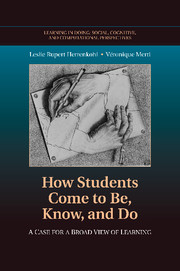Book contents
- Frontmatter
- Contents
- Series Foreword
- Acknowledgments
- How Students Come to Be, Know, and Do
- Introduction
- 1 The Context Lens
- 2 How Ways of Knowing, Doing, and Being Emerged in the Classroom: Interpersonal Interactions and the Creation of Community, Part I
- 3 How Ways of Knowing, Doing, and Being Emerged in the Classroom: Interpersonal Interactions and the Creation of Community, Part II
- 4 Personal Lens of Analysis: Individual Learning Trajectories
- Conclusion
- References
- Index
- Titles in the series
3 - How Ways of Knowing, Doing, and Being Emerged in the Classroom: Interpersonal Interactions and the Creation of Community, Part II
Published online by Cambridge University Press: 06 December 2010
- Frontmatter
- Contents
- Series Foreword
- Acknowledgments
- How Students Come to Be, Know, and Do
- Introduction
- 1 The Context Lens
- 2 How Ways of Knowing, Doing, and Being Emerged in the Classroom: Interpersonal Interactions and the Creation of Community, Part I
- 3 How Ways of Knowing, Doing, and Being Emerged in the Classroom: Interpersonal Interactions and the Creation of Community, Part II
- 4 Personal Lens of Analysis: Individual Learning Trajectories
- Conclusion
- References
- Index
- Titles in the series
Summary
As students took up questioning each other about their ideas during reporting, we found other ways of being, doing, and knowing were opened up for renegotiation and redefinition inside the classroom. The students' interactions raised a host of issues that are taken for granted in the context of more traditional classrooms. For instance, speaking rights in a traditional classroom are well understood by fourth graders. If you raise your hand and the teacher calls on you, you have a chance to speak, most often in response to a question posed by the teacher. In our classroom context with students creating and responding to questions and Mrs. Glenda standing to the side to facilitate this process, traditional patterns of classroom speaking were no longer possible to engage. This was especially true once students developed a strong desire to ask questions and learned how to create or appropriate content critical questions. When preparing a report, students had to decide who would present each part of the report. Students had to negotiate which audience members would ask a question first when multiple hands were raised. Reporters had to determine which reporting partner would respond to the questions from the audience. These interesting dilemmas of who had the right to speak and when opened another window into better understanding how ways of knowing, doing, and being emerged together and influenced the values and rules of engagement that came to distinguish this classroom.
- Type
- Chapter
- Information
- How Students Come to Be, Know, and DoA Case for a Broad View of Learning, pp. 102 - 147Publisher: Cambridge University PressPrint publication year: 2010

